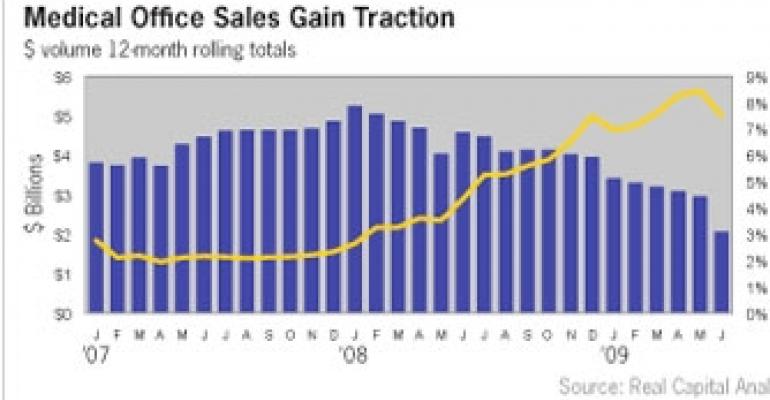Already enjoying a surge in investment activity, the burgeoning medical office sector is poised for an even larger boost, if Congress approves President Obama’s sweeping overhaul of the nation’s health care system. The plan could cost at least $1 trillion over the first 10 years, according to experts.
“The overriding goal of health care reform is simply this — to expand access, quality and affordability,” says Al Pontius, national director of Marcus & Millichap's office and industrial properties group, based in San Francisco. “Consequently, you’re going to see very solid demand characteristics for medical office buildings over the longer term, and in particular related to health care reform.”

Already a major health care overhaul is underway. The American Recovery and Reinvestment Act of 2009 includes an allocation for prevention and wellness intervention that places a stronger focus on primary care physicians.
An estimated 8,000 additional primary care doctors will be needed to care for the newly insured that result from the reform, according to a recent report from Encino, Calif.-based Marcus & Millichap. Just half of these new doctors would generate an additional 7 million sq. ft. of demand for medical office space.
Demographics also bode well for the sector. Currently, baby boomers account for 29% of all uninsured Americans. If reform increased health care insurance coverage for 95% of all boomers, doctor’s visits would also rise by 34 million each year, according to Marcus & Millichap, which tracks medical office buildings used by physicians and laboratories such as surgery centers and other retail outpatient facilities.
Pontius cites a prime example of the impact of health care reform on commercial real estate. Massachusetts’ version of universal health care reform enacted in 2006 resulted in 97% health care coverage of the state’s population. Over the past three years, the increased demand has translated into a 14% increase in the state’s medical office inventory, or 1.8 million sq. ft. of new space.
Investors also have responded positively to the reform. Last year, the dollar volume of medical office transactions in Massachusetts rose 55%. With the state’s budget shortfall, however, Massachusetts is struggling to pay for the program, which requires nearly everyone in the state to have health insurance.
Whatever the eventual outcome of national health care reform, property fundamentals for the medical office sector are already on a firm footing. “Out of all the niches, medical office has the lowest amount of distress at only 1%, or nearly $200 million, which is nothing compared to the $18 billion in the traditional office sector,” explains Jessica Ruderman, senior analyst with New York-based research firm Real Capital Analytics. The research firm defines distressed properties as those that are in foreclosure, bankruptcy or for which the loan is being restructured.
Nationally, medical office transactions of $5 million and higher are on the rise. For the first half of 2009, medical office sales accounted for 8.4% of all office transactions, compared with 7.6% in the same period last year. “Typically it’s been around 2% to 4% for all other years,” notes Ruderman.
Although the economy has caused office vacancy rates to spike across the board, the blow to medical office appears much less severe. The vacancy rate for medical office is projected to end the year at 12.4%, up 100 basis points from a year earlier, while general office vacancies are expected to breach 17%.
Despite the rosy outlook, the medical office sector isn’t insulated from risk. “We have been adding medical office space aggressively to the national inventory now for the past several years,” notes Pontius. More than 17 million sq. ft. of new space came to market last year, according to Marcus & Millichap, and another 14.1 million sq. ft. is slated for completion in 2009.
“There are some markets like Phoenix and Las Vegas that are clearly overbuilt today for the current level of demand,” says Pontius. Nearly one-third of the new inventory last year was built in Southwest where housing boomed and healthy population growth bolstered demand. The economy and unemployment have taken a toll as cash-strapped consumers have cut back on elective health care services.
But perhaps the most distinguishing characteristic of the medical office sector is strong valuations. At mid-year, medical office space fetched $251 per sq. ft., up from $218 per sq. ft. in mid 2008, a 15% jump. In contrast, the general office valuations were down 24% over the same period. “If you’re looking for a safe asset that you want to hold long term,” says Ruderman. “I would say buy medical office.”

